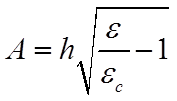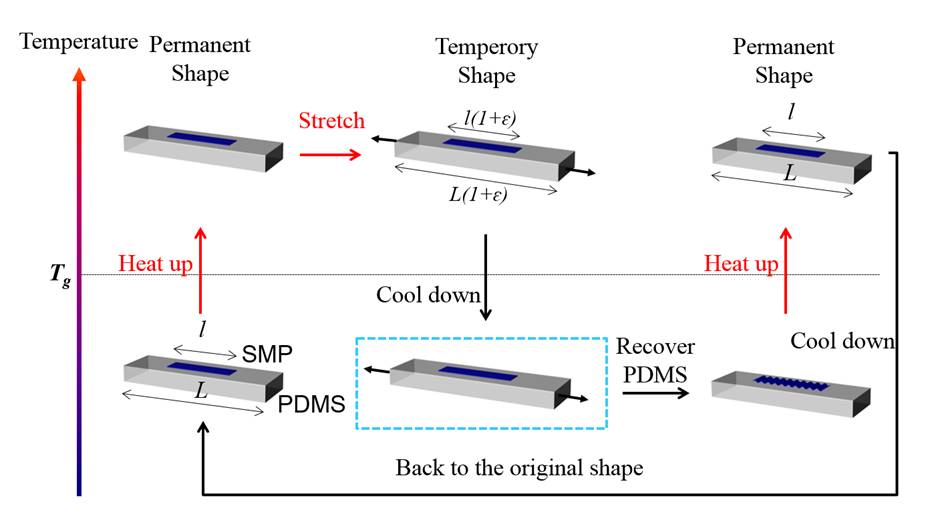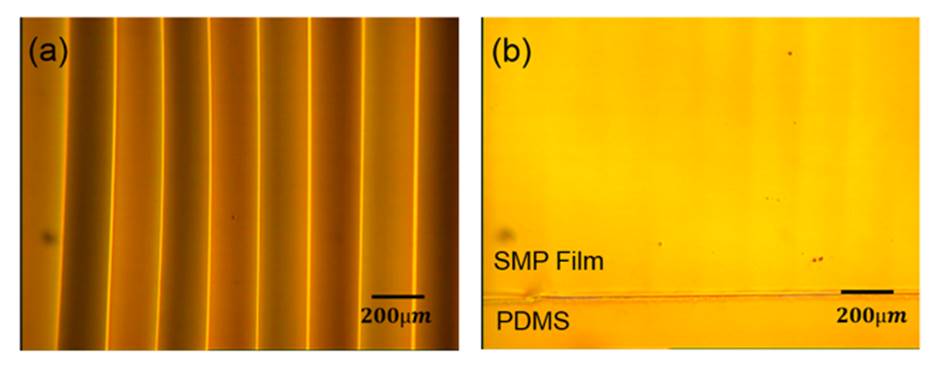Reports: DNI753780-DNI7: Tunable Temperature-Responsive Surface Morphologies of Polymer Heterostructures
Jianliang Xiao, PhD, University of Colorado Boulder
Shape memory polymers (SMPs) can memorize different shapes and recover to their original shapes upon appropriate stimulations, including heat, humidity, electrical and magnetic field. This study was to realize tunable temperature-responsive surface morphologies of polymer heterostructures by harnessing instabilities of shape memory polymer (SMP) thin films on compliant Polydimethylsiloxane (PDMS) substrates.
PDMS substrate was made from Sylgard 184 elastomer kit (Dow Corning) using a 20: 1 prepolymer-crosslinker ratio by weight. To synthesize SMP thin films, monomer tert-butyl acrylate (tBA) and cross linker poly (ethylene glycol) dimethacrylate (PEGDMA) were mixed at a ratio of 4:1 by weight, and 2, 2-dimethoxy-2-phenylacetophenone was added as the photo initiator. The glass transition temperature Tg of SMP made at this ratio is 42 0C. Polymer solution was injected into a mold, which was made by two glass slides with shims between them. Thicknesses of SMP thin films were determined by the shims. The mold with polymer solution was then placed under UV lamp for 5 minutes for polymerization followed by post-curing in oven at 80 0C for 1 hour. And then SMP sheet was demolded and cut into rectangular shapes with dimension of 15x5 mm. Film thicknesses were between 5~15 µm, measured by profilometer. The last step before proceeding wrinkling cycle was to transfer SMP thin films on top of PDMS slabs in room temperature.
Fig. 1. Processes of realizing tunable SMP thin film wrinkles on PDMS
The permanent configuration of the system was when a SMP thin film was transferred onto PDMS substrate. Then the film-substrate system was heated to 60 0C firstly, which is higher than Tg of SMP. And then the PDMS substrate was stretched with desired strain. SMP film was stretched by the same strain simultaneously due to the bonding with substrate. The system with constraint was cooled down to room temperature to fix the strain in the SMP film. Now, the temporary shape of the SMP film was obtained with programmed strain. This strain will not relax even if the SMP is detached from the PDMS substrate. Subsequently, the stretch applied on PDMS was released at room temperature, the SMP thin film wrinkled on top of the PDMS substrate. When the system was heated again, strain in SMP film was recovered and the wrinkling disappeared spontaneously. Both the SMP thin film and PDMS substrate returned to their original shapes and were ready for new cycles. This wrinkling cycle can be repeated for many times. And the strain in each cycle can be different, yielding tunable surface morphologies.
Fig. 2. Optical images of the wrinkled (a) and recovered (b) SMP thin film on PDMS.
Figure 2a shows an optical image of the wrinkling morphology of the SMP thin film of thickness 5.1 µm on PDMS. Bright lines in this figure are peaks or valley of the wrinkling pattern. Figure 2b is an optical image of the recovered system, which clearly shows almost perfect flat surface morphology.
Fig. 3. (a) The profiles of wrinkled SMP thin film on PDMS before heating and flat SMP thin film after heating, (b) Wrinkle amplitude versus the programming strain.
Another interesting extension of current results is to investigate the tunable hierarchical surface morphologies on 3D surfaces, such as microlens surfaces that can couple with optical properties. We have studied the mechanics and optics of stretchable elastomeric microlens arrays, to pave the way for tunable hierarchical surface morphologies. We have studied theoretically how to design an elastomeric microlens array that can be mechanically stretched without deteriorating the optical performance. Figure 4a illustrates the design of a unit cell in the microlens array, with one microlens sitting on top of a cylindrical post and connected to the base membrane. When the microlens array is subject to 10% equibiaxial stretching, the radius of curvature of the microlens normalized by its original radius of curvature versus the height ratio h/t is shown in Fig. 4b, and the corresponding normalized focal length is shown in Fig. 4c. The results imply that once the height ratio h/t is larger than 1, the effect of the base membrane stretching on the microlens is negligible. Fig. 4. (a) Design of stretchable microlens, (b) Normalized radius of curvature of the microlens surface versus the height ratio h/t, and (c) normalized focal length versus height ratio h/t, when the microlens array is subject to 10% equibiaxial stretching. This research project has generated results that can have potential applications in smart adhesion, sensors, stimuli-responsive optical gratings, precision metrology and tunable microlens arrays. It also led to a new direction in the PI's research group to study tunable hierarchical surface wrinkling and its coupling with optics. One graduate student, Zhengwei Li, was supported by this project, who is currently in his fourth year of PhD study, and plans to graduate by next year. He has published 7 journal articles in four years. Due to his accomplishment, Zhengwei has received two travel grants for attending conferences, and the GEERS fellowship from the University of Colorado Boulder. , (1)where h is the thin film thickness,
, (1)where h is the thin film thickness,  is the critical wrinkling strain, and
is the critical wrinkling strain, and ![]() and
and ![]() are the plane strain modulus of the substrate and the thin film, respectively. We are now trying to characterize the influence of SMP thin film thickness on the surface wrinkling behavior, as well as different strategies to program the SMP thin films in order to realize different methods for tuning the surface morphologies.
are the plane strain modulus of the substrate and the thin film, respectively. We are now trying to characterize the influence of SMP thin film thickness on the surface wrinkling behavior, as well as different strategies to program the SMP thin films in order to realize different methods for tuning the surface morphologies.















